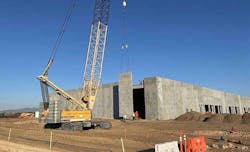Are concrete sidewalks bad for the environment? If so, what about those huge tilt-up walls that help assemble data centers?
“Cement is a major component of concrete and its production accounts for 7 percent of global CO2 generated, making it one of the largest contributors to carbon from the built environment,” said Rob Niven, the founder and CEO of CarbonCure Technology, a Nova Scotia company that’s on a mission to address this problem.
CarbonCure’s technology will be used in future projects by Compass Datacenters, the two companies said today. The announcement reflects a growing awareness of the need for sustainability to permeate all aspects of data center development, moving beyond energy efficiency and powering facilities with renewable energy.
Given the scale of new data center campuses, the impact of using low-carbon concrete can be substantial.
“Our data centers use concrete in many areas, from foundations and sidewalks to pre-cast walls and roofing,” said Nancy Novak, Compass Chief Innovation Officer. “We estimate using CarbonCure will reduce our CO2 footprint by an average of 1,800 tons per campus. That’s the equivalent CO2 sequestered by 2,100 acres of forest or driving a car 4 million miles.”
Concrete is Everywhere
Concrete is said to be the most widely-used man-made material on the planet, and second only to water as the most consumer resource. Its durability and strength make it ideal for building things that last. It is the leading component of bridges, dams, parking garages, and plays a huge role in the construction of data centers and other industrial buildings.
The issue is that the production of cement requires the use of massive kilns, which require large amounts of energy, and the actual chemical process of making cement also emits staggeringly high levels of CO2.
The carbon problems with cement are well known in construction, including the data center industry. But large users are cautious in making major changes in materials, given the downside of structural failures.
That’s beginning to change as sustainability becomes a priority for the largest users. In January, a clear call to action was issued in January by Microsoft, one of the largest customers for wholesale data center space. Microsoft made a commitment to be carbon negative by 2030, and said it will implement new procurement rules that will hold vendors accountable for their carbon impact.
“It’s really the supply chain,” said Microsoft President Brad Smith. “One of the big things is cement. When our new buildings are being built, and the concrete is being poured, it comes from cement. When cement is created, carbon is emitted. The same thing is true of steel; the same thing is true for the electrical components that go into Microsoft’s products.”
Stewardship and a Holistic Approach
Compass is one of the first data center developers to announce a greener concrete initiative, but it likely won’t be the last. Like most major data center developers, Compass is competing for construction projects to build new data center capacity for the largest hyperscale users – Microsoft, Google, Facebook, Amazon Web Services and Apple – who are increasingly focused on sustainability.
CEO Chris Crosby said that taking action on cement is consistent with the company’s larger approach to business.
“We view ourselves as stewards, and that guides the way we build data centers and work the land,” said Crosby. ” We view sustainability holistically, including all aspects of the data center, and not just green power.”
“By using CarbonCure technology in our concrete, we minimize our environmental impact without sacrificing quality,” said Adil Attlassy, Compass Chief Technology Officer. “Compass is helping the data center industry reduce its environmental impact with a holistic lens, supporting stewardship of our environment from construction through operations.”
CarbonCure CEO and founder Rob Niven at the company’s facility in Nova Scotia. (Photo: CarbonCure)
CarbonCure takes CO2 produced by large emitters like refineries and chemically mineralizes it during the concrete manufacturing process to make greener and stronger concrete. The process reduces the volume of cement required in the mixing of concrete, while also permanently removing CO2 from the atmosphere.
There are other companies offering low-carbon concrete products, including Solidia and bioMASON. CarbonCure has gained visibility through an investment by Breakthrough Energy Ventures, a large investment fund backed by Bill Gates, as well as a profile of the company in Wired magazine.
Novak said Compass’ use of CarbonCure has been well received by its partners in pre-cast construction, a process that allows pre-fabricated concrete panels to be deployed at a construction site, accelerating the construction of the walls and superstructure for a data center
Companies like Compass are steered towards low-carbon concrete by their sustainability ethos and customer priorities. But in some jurisdictions, it may soon become a requirement. Marin County in California recently passed the first Low Carbon Concrete Code in the United States.
About the Author




